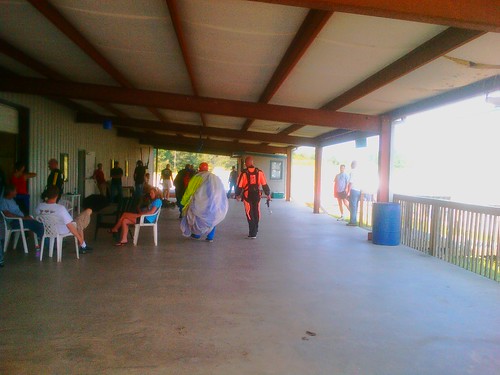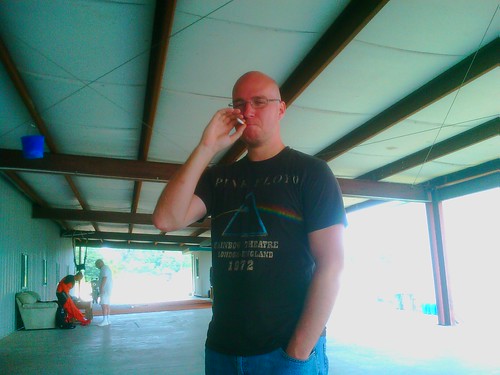
I was back up at Carolina Sky Sports this weekend for my third tandem jump. The original plan for the day was to do two tandem jumps at 12:00 and 2:00 PM. Unfortunately, mother nature intervened.
Sunday morning I was rudely awoken by the sound of thunder outside my bedroom window. A glance outside confirmed my fears. We were completely socked in. There was a glimmer of hope, however. The weather radar showed somewhat clear skies to the west as the storms made their way through the area. By 11:30 I was walking through the front door at CSS. Sadly, I was only able to make one jump at 4:00.

The previous two weeks I'd spent my free time reading through the SIM and reviewing the lessons learned on my first two jumps. This is where I appreciate an instructor like John Renfro. He drilled into me the key concepts I needed to be learning at this stage of my training.
The Three Ps
1) Pull
2) Pull at the correct altitude
3) Pull at the correct altitude and while stable
In addition to that I needed to learn to trust my arch as I exited the aircraft. The initial tandem jumps are intentionally unstable so as to reinforce that concept with novice skydivers. Just to make things a little extra hairy, the rear exit from the CASA 212 means you go from no wind to a whole lotta wind very quickly. That's not to say it isn't fun. It's a fucking blast going through that initial tumble while the world spins around you.
On the climb up my instructor Eric and I chatted briefly and traded a few jokes. This helped with another piece of advice John gave me: relax. If you're relaxed you're thinking clearly and can react properly in the event there is a problem. If everything goes according to plan then it means you're that much more clear headed and able to enjoy the jump. After all, that's why I'm jumping out of plane with a bunch of other lunatics. Because it's as much fun as you can possibly have with your pants on!
The final piece of advice that came from John was "Plan the jump and jump the plan." Running through the list of things I would be expected to do during my jump helped me to relax immensely as we climbed to 14,000 ft. It calmed that knot in my stomach as the aircraft lurched every so slightly as the first jumpers out disappeared from view.
This jump's plan was pretty straight forward:
1) Get to the edge of the ramp and Check in with the instructor.
2) After the thumbs up it will be Ready! Set! Go! and we're out of the aircraft.
3) Arch hard and get stable.
4) After the tap begin the skydive. Pick a heading and check your altimeter. We're around 12,000 ft so we have plenty of time.
5) Perform a right 360° turn.
6) Check your altimeter.
7) Perform a left 360° turn.
8) Check your altimeter.
9) Perform a Practice Handle Throw (PHT).
10) Check your altimeter (are you seeing a pattern here?).
11) Perform a Practice Handle Throw (PHT).
12) Check your altimeter.
13) Perform a Practice Handle Throw (PHT).
14) Check your altimeter.
15) At 6500 ft keep your eye on your altimete.
16) At 6000 ft wave off and pull!
Once the canopy is out check for There, Square, Stable, and Steerable. If it is then head on over to the holding area and get in line to land.
The downwind leg of the landing was spot on. We didn't bleed enough altitude on the base leg so we came in a little high and a little fast for the final leg and then hit a few cross gusts. It was interesting, but at that point you're close enough to the ground that you feel secure. Still, dropping onto the deck at this point would still earn you a broken leg.
We ended up flaring and just floating onto the deck at the LZ. However, due to the slight height differential between my instructor and I we both ended up on our asses.
Eric gave me a brief rundown on the post-jump procedures including gathering up the lines and taking everything back to the packing area and laying it out for the packing team.
All in all, it was a great jump!



No comments:
Post a Comment